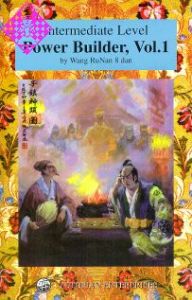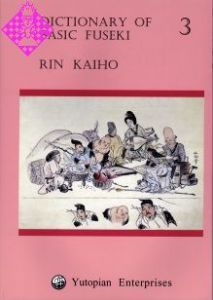Fuseki - nicht einbuchen/fakturieren
252 pages, paperback, Yutopian, 2000
Go - Life, Liberty, and the pursuit of Territory through Connection and Influence. Each player seeks to discover the strategy and tactics necessary to acquire the most territory. Ideally each play should pose multiple threats to create or destroy Connection, Life, Influence, and/or Territory.
The Fuseki Small Encyclopedia covers basic opening strategy for the game of go. Although a few common corner openings (joseki) are discussed, the idea here is to concentrate on applying the basic principles of whole-board openings (fuseki) so you can choose the joseki that is the most suitable for the whole-board position. After reading this book, you will find it easier to figure out what is important on the board and what to do when your opponent departs from the flow of the game.
Thirteen chapters examine the full spectrum of go openings, which are divided into twenty-nine specific patterns and strategies. The traditional order of play is emphasized - (1) empty corners; (2) a corner enclosure (shimari); (3) an approach of pincer; (4) an extension along the side; then lastly, (5) a jump out into the center - but popular departures from this order, such as three star points in a row (senrensei) and the Chinese fuseki, are given considerable coverage.
In addition, 94 openings are included from professional games for study.
| Weight | 330 g |
|---|---|
| Manufacturer | Yutopian |
| Width | 10.3 cm |
| Height | 16 cm |
| Medium | Book |
| Year of Publication | 2000 |
| Author | Nihon Ki-in |
| Language | English |
| ISBN-10 | 1889554251 |
| ISBN-13 | 9781889554259 |
| Pages | 252 |
| Binding | paperback |
| Name | Yutopian Enterprises |
|---|---|
| yutopian@netcom.com |
i Forward
vii Notes on Book Organization
viii Study Suggestions
001 Chapter 1: Two Star Points (Nirensei)
002 Pattern 1 White Two Star Points
005 Pattern 2 White Star and 3-4 Points
019 Pattern 3 White Opposing 3-4 Points and Others
025 Chapter 2: Three Star Points (Sanrensei)
026 Pattern 1 Black One Point Jump Reply
032 Pattern 2 Black Pincer Replies
038 Pattern 3 Black Knight Jump Reply and Others
043 Pattern 4 White Star & 3-4 Points (Komoku) and Others
047 Chapter 3: Star Point & Perpendicular 3-4 Point
048 Pattern 1 Black Corner Enclosure
059 Pattern 2 Black Mini Chinese
067 Chapter 4: Star Point & Facing 3-4 Point
068 Pattern 1 White Star Point & Perpendicular 3-4 Point
078 Pattern 2 The Kobayashi Style
085 Chapter 5: Chinese Style
086 Pattern 1 White Approaches the Star Point
092 Pattern 2 White 3-4 Point Side Extension
098 Pattern 3 White Knight Approach Offense & Defense
107 Chapter 6: Diverging 3-4 Points
108 Pattern 1 White One-Point High Approach
119 Pattern 2 White Knight Approach and Others
125 Chapter 7: Shusaku Style
126 Pattern 1 The Diagonal Extension Reply
134 Pattern 2 The Modern Style
141 Chapter 8: Facing 3-4 Points
142 Pattern 1 White One-Point High Approach
153 Pattern 2 White Knight Approach and Others
157 Chapter 9: Diagonal Points
158 Pattern 1 Diagonal Star Points
167 Pattern 2 Diagonal 3-4 Points and Others
173 Chapter 10: Opposing 3-4 Points
174 Pattern 1 Reciprocal 3-4 Points
187 Pattern 2 White Pincer and Others
193 Chapter 11: 3-3 Points
194 Pattern 1 Black 3-3 Points
201 Pattern 2 White 3-3 Points
207 Chapter 12: 4-5 and 3-5 Points
208 Pattern 1 Black 4-5 Point
214 Pattern 2 Black 3-5 Point
219 Chapter 13: Unusual Openings
Actual Professionals Fighting
229 Glossary
233 Subject Index
244 Player Index
246 Game Index
This book covers basic opening strategy for the game of go. Although a few common comer openings (joseki) are discussed, the idea here is to concentrate on applying the basic principles of whole-board openings (fuseki) so you can choose the joseki that is the most suitable for the whole-board position. After reading this book, you will find it easier to figure out what is important on the board and when your opponent departs from the opening flow of the game.
Thirteen chapters examine the full spectrum of go openings, which are divided into twentynine specific patterns and strategies. The traditional order of play is emphasized: (1) empty corners; (2) a corner enclosure (shimari); (3) an approach or pincer; (4) an extension along the side; then lastly, (5) a jump out into the center - but popular departures from this order, such as three star points in a row (sanrensei) and the Chinese fuseki, are each given considerable coverage.
A word on technical terms used in this book. While we have tried to minimize the use of Japanese go terms, a number have been retained because of their use in the go community or the lack of adequate terms in English. Technical terms are defined when first presented, but we have included a glossary at the end of the book for definitions as needed.
Please send any comments or suggestions to Yutopian Enterprises. They will be much appreciated.
-
 Tesuji Made Easy For Windows€59.95
Tesuji Made Easy For Windows€59.95 -
 WeiQi In Culture 1€12.50
WeiQi In Culture 1€12.50 -
 Dictionary of Basic Fuseki 4€18.50
Dictionary of Basic Fuseki 4€18.50 -
 Power Builder, Vol. 1€17.00
Power Builder, Vol. 1€17.00 -
 21st Century New Openings€15.50
21st Century New Openings€15.50 -
 Dictionary of Basic Fuseki 3€18.50
Dictionary of Basic Fuseki 3€18.50

